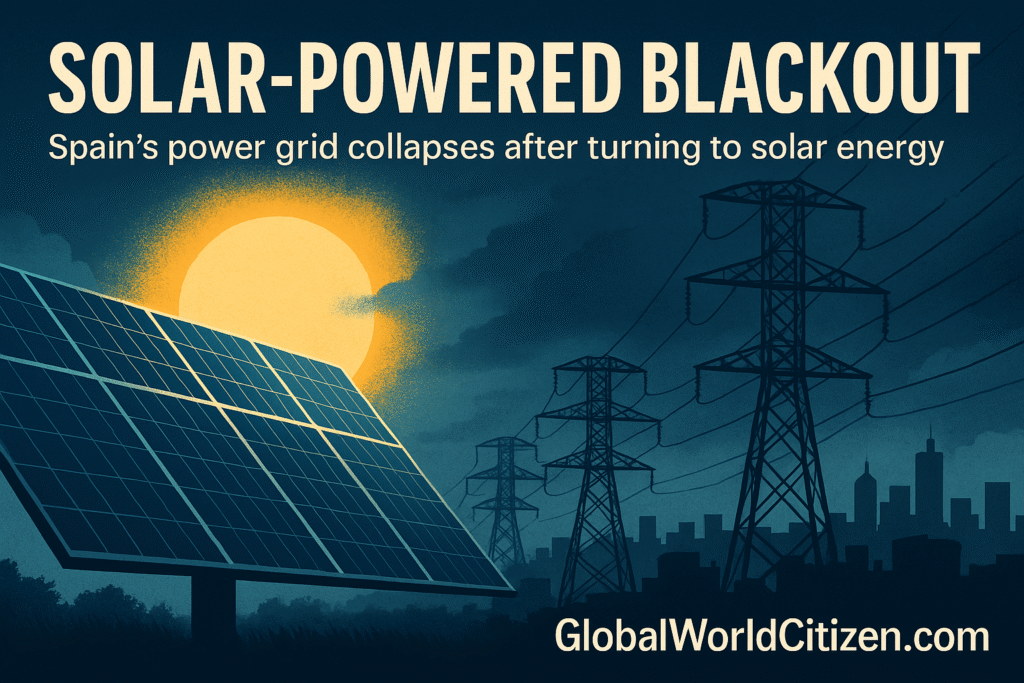Published Date: April 30, 2025
 Author: Global Energy Systems Desk
Author: Global Energy Systems Desk
 Source: GlobalWorldCitizen.com
Source: GlobalWorldCitizen.com
What was hailed as a historic solar energy milestone for Spain has now turned into a global cautionary tale. Just days after Spanish officials celebrated running the national grid entirely on renewable energy, the system collapsed in dramatic fashion — leaving millions without power across Spain, Portugal, and parts of France.
The failure occurred at high noon on Monday, precisely when solar output peaked. Yet, instead of showcasing the strength of green energy, the moment exposed deep infrastructure fragilities, weak grid resilience, and the consequences of politicized energy policy.
 From Solar Triumph to Nationwide Blackout
From Solar Triumph to Nationwide Blackout
Spain had proudly declared its first full day powered by 100% renewable energy, primarily solar and wind. But by the next afternoon, over 50% of the nation was still in the dark.
The root cause? A lack of synchronous inertia — the stabilizing physical energy traditionally provided by nuclear plants, hydroelectric turbines, and gas-powered generators.
At the time of collapse, only 30% of Spain’s power came from such stable sources
The rest was dominated by intermittent renewables, which lack the built-in inertia to handle sudden shifts in supply and demand
 Grid Engineering Undermined by Political Idealism
Grid Engineering Undermined by Political Idealism
Energy experts have long warned that transitioning too quickly away from base-load power without grid-stabilizing technologies risks system-wide collapse. Spain ignored these warnings.
Key contributing factors:
Premature shutdowns of nuclear plants
Tax penalties and regulatory pressure on conventional power stations
Market incentives that over-prioritized renewables without requiring backup generation
 Physics vs. Politics: Why Inertia Matters in Power Grids
Physics vs. Politics: Why Inertia Matters in Power Grids
Unlike wind and solar, thermal power sources like nuclear and gas turbines provide rotational inertia, which keeps the grid stable during fluctuations. Without it, voltage and frequency collapses can cascade — which is exactly what happened.
“Inertia is not optional. You cannot run a stable grid on ideology alone,”
— Dr. Mariana Estevez, Energy Systems Engineer
Spain’s policymakers had ignored technical models and expert advice, favoring political optics over operational reliability.
 GWC Insight: A Global Wake-Up Call for the Energy Transition
GWC Insight: A Global Wake-Up Call for the Energy Transition
At GlobalWorldCitizen.com, we see Spain’s blackout as more than a national crisis — it’s a global warning. As countries worldwide accelerate the shift toward clean energy, they must also respect the engineering, physics, and system dynamics that underpin grid stability.
 GlobalWorldCitizen.com Key Takeaways
GlobalWorldCitizen.com Key Takeaways
 1. Overreliance on Intermittent Renewables Is Risky
1. Overreliance on Intermittent Renewables Is Risky
Solar and wind lack grid-stabilizing inertia, especially during peak production hours.
 2. Synchronous Power Still Matters
2. Synchronous Power Still Matters
Nuclear, hydro, and turbine-based energy sources provide critical inertia and backup capacity.
 3. Ideology Cannot Replace Engineering
3. Ideology Cannot Replace Engineering
Policymakers must balance ambition with technical realism and grid planning fundamentals.
 Final Word from GlobalWorldCitizen.com
Final Word from GlobalWorldCitizen.com
Spain’s grid failure sends a global message: the green transition must be engineered, not improvised. Nations cannot simply unplug from fossil fuels or nuclear energy without investing in the infrastructure, energy storage, and grid stability mechanisms needed to sustain 24/7 power.
We support a clean energy future — but it must be one built on smart design, balanced energy mixes, and science-based policies.

Global energy disruptions
Climate-smart engineering
The future of sustainable infrastructure
We decode the data. You power the future.

